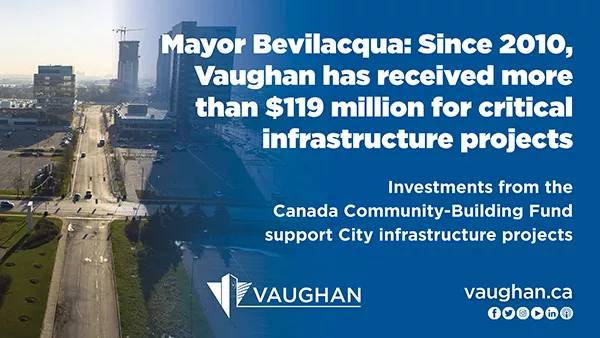Since 2010, Vaughan has received more than $119 million for critical infrastructure
As the City of Vaughan continues to prosper, thrive and grow, new demands are placed on local infrastructure, including roads, sidewalks and buildings. The federal Canada Community-Building Fund (CCBF) helps municipalities address the budgets to maintain, revitalize, and build new infrastructure essential to providing citizens' exceptional quality of life and creating the right environment for investment, job creation and economic prosperity.
Since 2010, the City of Vaughan has received more than $119 million in CCBF funding to build, enhance and improve projects, like bridge rehabilitation, hiking trails and multi-use paths that promote alternate modes of travel, including walking and cycling. Investments further supported stormwater management facilities, the Civic Centre Resource Library, Vaughan Fire and Rescue Service Station 7-10, and the Pavement Management Program, which focuses on maintaining appropriate service levels of the City's existing road network.
In March 2021, the Government of Canada announced an additional $2.2 billion in the CCBF to help prepare communities for economic recovery from the global COVID-19 pandemic. This investment doubled the federal government's regular allocation for municipalities in 2020-21 to provide much-needed financial resources to help reduce the risk of infrastructure projects being delayed or cancelled, and help offset the impact on municipal revenues due to COVID-19 public health measures.
The Association of Municipalities of Ontario (AMO) delivers the CCBF to all Ontario municipalities (excluding Toronto) twice a year, on a per capita basis. In 2021, an additional $648 million was provided to Ontario and distributed under the allocation formula used for payments made in 2020. Vaughan's CCBF top-up allocation is approximately $9.3 million, bringing total funding in 2021 to $19 million. This is welcome news as the City of Vaughan continues to prepare the 2022 Budget and 2023 to 2026 Capital Plan.
As the City looks ahead, Vaughan staff have identified existing capital projects for CCBF funding, including the stormwater management facility for Gallanough Park, roads rehabilitation/reconstruction, watermain and street lighting replacement, and Black Creek channel renewal design and construction. Projects were prioritized based on the City's asset management framework, with consideration also given to the projects' long-term financial and economic impacts. Business cases were reviewed to align with the 2018-2022 Term of Council Service Excellence Strategic Plan.
QUOTE
"Municipalities like Vaughan are the engines that drive our national economy. Cities are critical to Canada's post-COVID recovery, and the Canada Community-Building Fund (CCBF) helps us meet that challenge. Since 2010, Vaughan has secured more than $119 million in funding to invest in better roads, recreation facilities and to upgrade water and wastewater systems that protect the local environment. The CCBF also helps municipalities reduce pressure on property taxpayers by securing investment from different sources to fund, advance and complete city-building priorities. Today, Vaughan proudly maintains one of the lowest tax rates in the Greater Toronto Area. Competitive property tax rates and tax relief measures, more broadly, help provide much-needed support to citizens and local businesses while attracting new investments to our city. We are grateful for the continued partnership with the federal government and AMO."
- Mayor Maurizio Bevilacqua
QUICK FACTS
- The Gas Tax Fund was first established in 2005. As of June 29, 2021, the name changed to Canada Community-Building Fund to better reflect the program's evolution over time.
- The City of Vaughan's 2020/21 allocation, including the top-up, is $19 million.
- Eligible categories under the CCBF include public transit, wastewater infrastructure, drinking water, solid waste management, community energy systems, local roads and bridges, capacity building, highways, local and regional airports, short-line rail, short-sea shipping, disaster mitigation, broadband and connectivity, brownfield redevelopment, culture, tourism, sport and recreation.
LEARN MORE
- 2022 Budget public service announcement
- Association of Municipalities Ontario webpage
- Infrastructure Canada – The Canada Community-Building Fund
- Allocation of Additional Canada Community-Building Fund in 2021 staff report
- vaughan.ca/IGR

